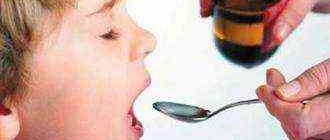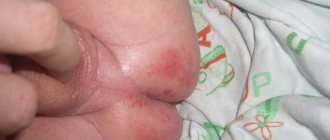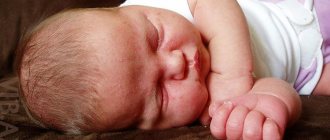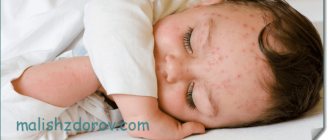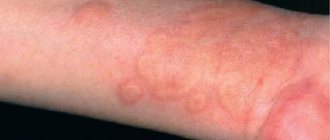You should not assume that children's skin will always be as silky and smooth as in television advertising or postcard photographs. Skin rashes, other problems, unevenness are quite common for infants, and not only. In this case, it is necessary to distinguish when a rash is a sign of a disease. When in doubt, be sure to take your baby to the doctor.
A rash is a pathology that forms on the skin (or mucous membranes), which differs from healthy skin in texture, color, and appearance. The rash consists of spots, blisters, papules, blisters that form on the skin, against the background of redness or at the site of old defects. Sometimes a small rash can appear on the stomach, body, back, cheeks, sometimes it itches and causes anxiety. All this is important to take into account in order to make the correct diagnosis.
In most newborns, you can notice white dots on the face, which are called “miles”. This phenomenon is completely normal and will go away in a few days.
Rash on a child’s neck: redness, signs of infection
A healthy baby's skin does not have any irritation or redness; it is soft, smooth and tender. A small child needs to be provided with proper care, as the skin is easily injured, inflamed, and rashes often occur, especially in the area of the folds of the hips, elbows and neck. Of all the types, rashes in the neck area are the most common. It may be caused by a microbial or fungal infection, prickly heat, or other problems. What to do?
Rashes due to enterovirus infection in children
The most common forms of the disease are respiratory and intestinal. The variety of symptoms is due to the existence of many serotypes of enteroviruses. The same infectious agent causes different symptoms in different children. Enteroviral disease is not accompanied by rashes in every case.
After the end of the incubation period of the pathogen, the temperature rises to subfebrile and febrile values. Symptoms of intoxication are noticeable - lethargy, loss of appetite, anxiety. Cough and other catarrhal symptoms can occur with both respiratory and intestinal forms of infection.
Enteroviral rash in children is most typical of exanthema. also called “Boston” and “epidemic”. The rash appears one day after the acute onset of the disease. Dots, spots and papules appear on the child's face and neck. Enteroviral exanthema lasts about a week and goes away without serious consequences for the child’s health.
Herpetic sore throat is one of the symptoms of enteroviral disease in children with reduced immunity.
The onset is acute: the child’s temperature rises to 38–41°C, the skin turns pale or red, and convulsions may develop. The high temperature persists for three days. On the second day after the onset of the illness, a small red rash (like dots) forms in the child’s throat. The next day, the rashes turn into herpetic blisters, which burst and leave erosions on the mucous membrane. It takes about 7 days from the moment the rash appears in the throat until recovery. There is no specific treatment for enteroviral disease. Conduct symptomatic therapy, provide bed rest, gentle nutrition.
What factors can cause a rash on the neck in children updated: October 30, 2021 by: admin
Rash on a baby’s neck: what it looks like
The skin of babies is thin and sensitive, so parents often notice peeling, irritation or various rashes, especially in the area of skin folds. One of the common localizations of redness and problems is the baby’s neck and behind the ear area. The neck of young children is short, with many skin folds. During feeding, milk or formula may flow down the cheek onto the neck, remaining there and irritating the skin if the baby is not washed after feeding. There may also be irritation when regurgitating some of the milk.
Often a rash appears on the neck - usually these are red, flat or raised elements, which are especially densely concentrated around the folds. Most often this problem occurs in babies in the first six months of life; as they grow, most of the redness and rashes disappear. The main causes of skin rashes can be irritation, prickly heat, or a skin infection of microbial or fungal origin.
Causes of a rash on a child's neck
There are many factors that cause a skin rash on a baby's neck. Some types of rash may only appear in the neck area, while there are some other types that may also affect diaper folds, armpits, and popliteal areas. Among the main causes of redness or loss of skin integrity are non-infectious and infectious problems.
Stork stings are localized areas of redness that appear on the back of the neck in babies a few weeks after birth. The child is not worried at all if they are felt. This is not a rash, but defects in the skin blood vessels, concentrated capillaries that form redness. They gradually disappear during the first years of life and do not require treatment.
Miliaria is the most common cause of skin rashes. It occurs in the summer or at any time of the year if the baby is dressed very warmly and constantly sweats. Compounds in sweat and liquid irritate the baby's delicate skin. These rashes appear as tiny red, itchy bumps on the skin. If you run your hand over them, they feel like tiny needles.
Prickly heat on baby's neck
The rash is pink or red in color and is mainly localized in the folds of the body. The main causes of prickly heat are overheating and lack of proper hygienic care for the child’s body. After the formation of a rash, it is necessary to wash the baby’s skin with soap and change the underwear. The child should not sweat; for this, the optimal temperature in the room should be maintained, and not overly wrapped or dressed.
A rash with heat rash in a child appears around the neck, in the groin folds, near the diaper due to blockage of the sweat glands. Beige-pink or red pimples appear on the shoulders and upper chest, located between the folds of skin on the legs, on the butt, and in the natural curves of the body. The elements of the rash are small blisters and nodules - located close to each other.
What should parents do:
- Place a baby who cannot yet roll over on his stomach to prevent the appearance of a rash on the back of his neck.
- Leave the child without clothes and a diaper for some time (air baths).
- Bath the baby in infusions of herbs - string, chamomile, calendula, sage.
- Use powder to care for baby's skin folds.
- Do not lubricate affected areas of the body with greasy creams.
- Choose clothes for your baby from natural soft fabrics.
- Maintain the temperature in the room +20...+22°C.
- Use Bepanten and zinc ointments.
The pimples will disappear in a few days with improved hygiene and additional care for the affected areas of the body.
Miliaria is not an infectious disease that has almost no effect on the general health of children. A rash on the shoulders of a child, formed by blisters with a diameter of 0.5–2 mm, leaves behind crusts. It is easy to prevent heat rash; you need to follow hygiene rules and ensure good ventilation of the body. Particular attention will be required in the summer, when with the onset of heat outside, cases of children overheating, sunstroke and heatstroke become more frequent.
Skin irritation, infection
If the child is a young child, a rash on the neck is common in the first few months. First of all, it is formed because their neck area is chubby, subcutaneous fat is concentrated there. This leads to the formation of skin folds that constantly rub against each other. Excessive moisture and constant friction are the main triggers of a rash on the baby’s neck. The rash constantly recurs with the slightest defect in care until the baby learns to lift and hold his head without any support (which can take several months).
Fungal infection (cutaneous candidiasis) is common in infants. Excess moisture and sweating of the skin in the child’s neck area become fertile ground for fungi of the genus Candida. In children, yeast infection is one of the most common causes of skin rashes on the neck. However, a microbial infection is also possible, which is provoked by opportunistic flora that constantly lives on the baby’s skin. This condition is called pyoderma, it is dangerous and requires immediate treatment.
You read a lot and we appreciate it!
Leave your email to always receive important information and services to maintain your health
Allergic rash in a child
Allergens enter the body with food or directly affect the skin (hygienic cosmetics, underwear, clothing). The rash appears as spots, nodules, and blisters. Color and size may vary, as will the sensations the baby experiences. Rashes in young children are accompanied by poor sleep, poor appetite, restlessness or lethargy.
Symptoms of an allergic rash in a child on the neck and shoulders:
The neurotransmitter histamine is responsible in the body for the reaction to the introduction of various infectious agents and the appearance of toxins. Free histamine appears in tissues in response to skin damage, stress, and penetration of foreign chemical compounds. A useful, life-saving reaction for the body sometimes takes on a perverted character. Histamine is released even when exposed to non-hazardous factors or substances.
Allergic reactions weaken the immune system, cause disturbances in the body and reduce the child’s quality of life.
The rashes are characteristic of allergic dermatitis, urticaria, eczema, and neurodermatitis. A small rash like goosebumps in a child, Quincke's edema, anaphylactic shock - all these are also manifestations of allergies. Anaphylaxis and oropharyngeal edema are life-threatening, causing suffocation and death.
Hypersensitivity of the body can occur in relation to any substance. A hereditary predisposition to overreact to certain stimuli has a significant influence. Antibiotic rashes often occur in children prone to allergies. The list of medications that cause rashes is updated every year. This list begins with penicillin and sulfur-containing drugs. Unfavorable environmental conditions, dietary patterns and diseases of the digestive system contribute to the development of allergic diseases.
Rash symptoms: redness, bumps, purulent pimples
The most common manifestations are redness, weeping, and itching of the skin accompanied by discomfort. The baby cries and is capricious, may refuse to eat, and sleeps poorly. The skin may also peel and become covered with small pimples with watery or white heads. There is pronounced redness at the base of the pimples. If they open, small erosions or crusts appear, which increases irritation or itching.
Skin care, methods for eliminating rashes
Most cases of mild skin rash go away on their own within a few days. They do not require any treatment. But the child may be worried and capricious during this period due to constant burning and itching sensations. To soothe their irritated skin, you need to use only light and breathable fabrics that do not cover the baby’s neck. It is important to avoid friction on seams, fasteners and edges of clothing in places where the skin is irritated. If the house is warm, the baby can wear a diaper and a light cotton T-shirt. Do not wash your child's clothes using strong bleaches and regular detergents. The aggressive chemicals in their composition, remaining on the fabric fibers, can cause skin irritation and lead to a rash.
If the folds of skin on the neck are damp, you can use talcum powder or cornstarch. This will keep the skin in the neck area dry. You can try adding a decoction of oats to your baby's bath. It helps dry and soothe the skin, eliminates redness and irritation. After bathing, you need to thoroughly dry all the folds on your neck.
It is important to follow the rules of skin hygiene, bathe your baby daily in warm water using only children's, mild and hypoallergenic body washes. You should not use washcloths; you can wash all the folds of the skin with a soapy hand or a soft sponge; there is no need to rub the irritated areas. It is important to follow the recommended bathing times. To prevent the skin from getting too wet, against the background of redness and irritation, it may itch more.
If your baby spits up milk or formula, you should immediately wipe his face and neck with a damp cloth and then wipe him dry with a soft towel. To reduce irritation and inflammation of the skin folds, you can use a baby cream or a special protective one used under a diaper. It contains zinc, which has a drying and anti-inflammatory effect. It is worth refusing to use oils, as they do not allow the skin to breathe, creating a greenhouse effect, which only worsens the condition.
Treatment tactics
In order to cure allergic irritation on the chest and neck, it is necessary to identify the substance that caused the rash on the neck, interrupting interaction with it.
To prescribe adequate treatment, an integrated approach with preliminary consultation with a specialist and a diagnostic examination is recommended. Almost any allergic reaction requires oral administration of long-acting antihistamines with minimal side effects (Claritin, Zyrtec, etc.).
Local irritation in the neck area can be effectively treated with anti-inflammatory ointments, gels, and creams. The most commonly used are water-based emollient creams and ointments, which are applied in a thick layer and rubbed until completely absorbed into the skin. Such external products moisturize the skin well, relieve itching, prevent scratching and relieve skin irritation.
If the situation worsens, when irritation is not relieved by simple hypoallergenic ointments and causes arise for the possible development of skin dermatitis or eczema. In this case, it is recommended to use external steroid agents. However, a cautious approach to such treatment is recommended. Taking into account all the reasons for the development of allergies in an adult patient and a child, an individual dosage is selected.
Hygiene measures are of great importance. Regularly taking a warm bath reduces itching, relieves skin irritation in the baby, and eliminates discomfort in the neck and shoulders.
In addition, treatment requires adherence to a special diet, excluding highly allergenic foods.
Minor rashes and redness can be effectively treated using traditional medicine recipes if you regularly make lotions with medicinal herbs (sage, chamomile, nettle, celandine, etc.). However, before using traditional methods in an adult patient or a child, it is recommended to first consult with your doctor in order to prevent an exacerbation of the allergy when the rash spreads to the face, cheeks, and ears.
For preventive purposes, it is necessary to strengthen the immune system, because the weakening of the body’s defenses provokes allergic irritation. It should be noted that at present, allergies cannot be cured completely, but an acute allergic reaction is effectively neutralized with complex treatment.
Sources: , ,
How and how to properly treat diaper rash on a baby’s neck
When a little person is born, responsible parents immediately surround him with maximum care. After all, he is still so small and defenseless and everyone in the household is trying to wrap him up tighter. Often, such excessive care affects the baby’s delicate body with diaper rash. After all, the baby’s thermoregulation system has not yet been fully adjusted. The skin is very delicate, thin and sensitive, the blood vessels are located too close to the surface, the skin reacts to the slightest irritation, or even overheating.
Types of diaper rash
This type of inflammation of the skin varies in severity. At the very initial stage, the only symptom of the disease is hyperemia. The skin becomes red, there are no more signs. If measures are not taken in time, the redness of the skin will intensify even more, and small cracks and even small erosions may appear in the affected areas.
If nothing is done at this stage, the inflamed skin becomes covered with ulcers and ulcers, and there is a strong unpleasant odor.
In the first stage, diaper rash causes mild itching. At the second stage, the itching intensifies, a burning sensation is added, and the skin dries out. At the most advanced stage, the child feels not only itching and burning, but also pain and severe discomfort. The baby can neither eat peacefully nor sleep peacefully.
Important to remember! The advanced stage of prickly heat can be accompanied by a bacterial infection, which causes the body temperature to rise. In such a situation, it is necessary to take antibacterial drugs, which are prescribed by an experienced specialist. .
If you start treating this problem in a timely manner and eliminate all provoking factors, then the disease quickly disappears and does not cause any harm to the health of the child as a whole.
Neither a child who is overly cared for, heavily wrapped up, nor a baby who experiences a lack of maternal care is immune from the appearance of this kind of skin inflammation. In the second case, diaper rash may appear as a result of insufficient hygiene procedures, when the child is sweating, but there is no hurry to bathe him.
Causes
But, unfortunately, not all factors causing diaper rash are so harmless and easily eliminated. In addition to severe overheating of the child, or rare bathing, there are a number of other reasons that provoke such inflammation, these are:
- Synthetic or too rough and tight clothing. Synthetics do not allow the skin to breathe, as a result the skin overheats and becomes inflamed. The same thing happens if the clothes are made of rough materials; the rough fabric irritates the baby’s thin, sensitive skin. Clothing that is too tight also does not allow sufficient oxygen to reach the body, resulting in skin inflammation. Children's bedding, blankets and towels should also be made exclusively from natural fabrics.
- Synthetic detergents for baby bathing. Unfortunately, in our modern times, more and more people suffer from various allergic reactions. And often children are born with individual intolerance to one or another drug. Even children's cosmetics are no exception, which can also cause an allergic skin reaction in children in the form of irritation and redness. It is also necessary to wash children's clothes only with mild, gentle detergents, and be sure to iron all children's accessories.
- Excess weight of a child also serves as a provoking factor for skin inflammation. If the baby is overweight, he sweats more, and many wrinkles appear on the skin, to which air access is limited. In such folds, as a result of skin friction and constant sweating, a moist, warm environment is formed in which bacteria quickly multiply and skin inflammation appears.
- Errors in nutrition can also affect the condition of the skin. Even any new feeding in infants can be reflected by skin hyperemia. Everything new should be introduced into the baby’s diet in a minimal amount, gradually increasing the dose.
- The most severe causes of diaper rash in infants are diseases: dermatitis, pyoderma, staphylococcal and streptococcal infections.
Diaper rash on the neck of infants occurs more often than on other parts of the body. This is due to the fact that there are constantly folds on the neck, the skin inside of which rubs and sweats excessively. Also, a child at this age often burps, and the acidic contents of such regurgitation remain in the skin folds and serve as a powerful irritant.
What does diathesis look like and what is it?
Diathesis is the most common type of rash that most often appears in infants. What does this unpleasant phenomenon look like? The photo clearly shows that these are scatterings of small pimples, which can sometimes be accompanied by peeling or itchy scales. Such symptoms cause a lot of trouble for the baby, because along with the rash comes discomfort and severe itching.
There are many reasons for the appearance of such an unpleasant symptom, and most often the mother’s poor diet leads to the formation of rashes. Scientists have found that a child can suffer from diathesis even in the mother’s stomach, and this can lead to considerable complications later.
The mother’s consumption of allergens is not necessarily the only reason for the appearance of the rash; there are also many provoking factors for the formation of these unpleasant signs on the baby’s delicate skin. Among them:
- change of residence, usually a move to an unfavorable climate;
- the composition of the microflora in the intestines is disturbed;
- carried out preventive vaccination;
- the child’s reaction to various allergens that may be in the room (pollen from indoor plants, pet hair, indoor dust);
- flowering of some shrubs or trees.
You should not try to find out on your own what exactly the child’s body reacts to with a profuse rash and peeling. You should definitely consult a doctor, who will determine what caused the irritating formations on the baby’s skin.
Read more about diathesis in children
How to fight
When diaper rash occurs, your baby requires careful care. First of all, it is necessary to detect and eliminate the cause of their occurrence. Also, the baby needs to be bathed regularly, while wiping the skin dry so that moisture does not remain in the skin folds. You need to dry your baby's skin carefully, without injuring it, with a soft natural towel. If diaper rash has just appeared, and there are no symptoms other than mild redness, then no additional medications are required.
You just need to bathe the baby in a decoction of medicinal herbs. Seedlings, chamomile, calendula, St. John's wort, and yarrow are perfect for these purposes.
You can purchase special herbal infusions for bathing children at the pharmacy. After water procedures, the baby needs to be provided with air baths: let him lie naked for several minutes. You can bathe your child without soap; it is enough to use it only 2-3 times a week. On hot days, bathing should be done 2-3 times a day. Dress the baby only in natural and loose clothing and monitor the temperature in the room; it should not exceed 23 degrees.
How to treat diaper rash in a newborn if it has already entered the second stage? This is a very important question. If, nevertheless, time is lost a little, then baby powder must be added to the water procedures, which is sprinkled on the affected areas, or they are lubricated with various creams containing zinc.
Talc and zinc have a drying effect and, together with decoctions of medicinal herbs, can effectively eliminate the problem. Instead of herbal decoctions, you can bathe the baby in a weak solution of potassium permanganate.
If diaper rash has already reached an advanced stage and pustules appear on the affected areas, you should immediately seek help from an experienced doctor. Only a doctor can prescribe effective antibacterial drugs. Self-medication in such cases is unacceptable.
Prickly heat on the neck of a baby - manifestation, treatment
Prickly heat on the neck of a baby is a common cause of concern for young mothers and fathers. The red rash on a tiny person looks scary. But is it worth worrying too much about this? How bad is heat rash?
The rash in newborns occurs due to excessive exposure to high temperatures and is characterized by a bright pink rash. Parts of the body that have the least contact with air are most often affected: folds in the neck, groin, and armpits. The rash requires special attention and care for the child.
Treatment of allergic rashes in children
Antihistamines stop the release of histamine and its entry into the blood. In this category of medicines, drugs of I–IV generations are distinguished. The first include the tablets “Diphenhydramine”, “Suprastin”, “Tavegil”. The active ingredients block histamine receptors, relieve itching, redness and swelling of the skin. Unfortunately, they cause undesirable effects such as drowsiness, lethargy, and dry mouth. The sedative effect of Tavegil tablets is less pronounced.
It is recommended that young children be given antihistamines in the form of drops or syrup for oral administration.
The drugs loratadine, azelastine, desloratadine, cetirizine have the positive qualities of the previous generation, act longer and do not cause drowsiness. Trade names of drugs: Claritin, Allergodil, Zyrtec. The first and last remedy is most often used to treat a red rash on the neck, face or entire body. Fenistil drops can be given to children over 1 month old, Zyrtec - from 6 months. The drug “Allergodil” relieves the symptoms of allergic rhinitis and conjunctivitis.
The combination of taking antihistamines with the application of anti-inflammatory ointments and the use of folk remedies greatly facilitates the child’s condition. If an allergic rash has formed on the head and neck, then add a decoction of oak bark or licorice root, an infusion of string, viburnum, chamomile, lemon balm, and calendula to the bathing water. Sea buckthorn and rosehip oil (applied to the rash) have a calming and healing effect. You can make your own extraction ointment from celandine herb and sunflower oil.
It is necessary to follow a diet. including the use of products approved by a doctor. The effect of food allergens on the body is weakened by enterosorbents, the simplest of which is activated carbon. Together with toxins, these substances can remove beneficial microflora from the intestines. To restore balance, it is recommended to take the drug “Hilak Forte”.
Causes of prickly heat on the neck in a newborn
Prickly heat on a child’s neck is associated with insufficient development of the skin. Babies' skin is very thin, so any exposure to the external environment will damage it. Sweat glands in children develop only by the age of 3-5, which also contributes to the development of prickly heat, because sweat in this case accumulates in the surface layer of the skin. A large number of blood vessels in the skin of infants is one of the causes of heat rash. Young children are very sensitive to high temperatures and sweat quickly. Also, the body of a newborn differs from an adult in that it contains a lot of water: about 90%.
Infectious rash on the back of the head in a baby
Rashes in a child can be of both viral and infectious origin. In this case, the type of affected skin can be completely different. These can be either ulcers or small pustules.
Parents rarely have to deal with this problem, but it does happen.
Skin rashes can cause:
- Streptoderma;
- Staphylococcus infection;
- Pseudotuberculosis;
- Erythema infectiosum;
- Measles virus.
Erythema infectiosum
Such diseases pose a great danger to the child’s health and usually have other manifestations in parallel. The first and most pronounced reaction to infectious rashes is a temperature that reaches high levels. In this situation, you should always seek medical help.
